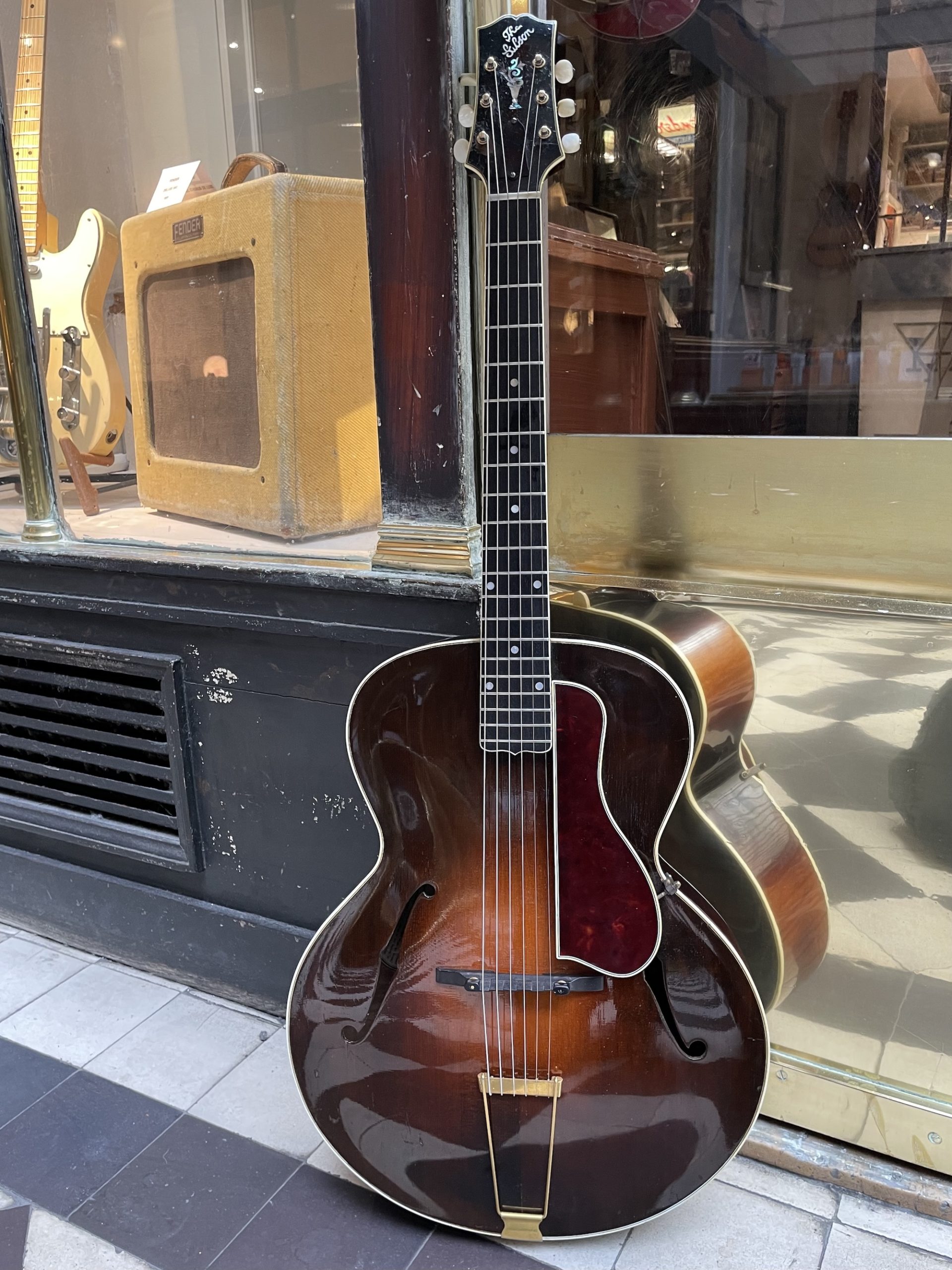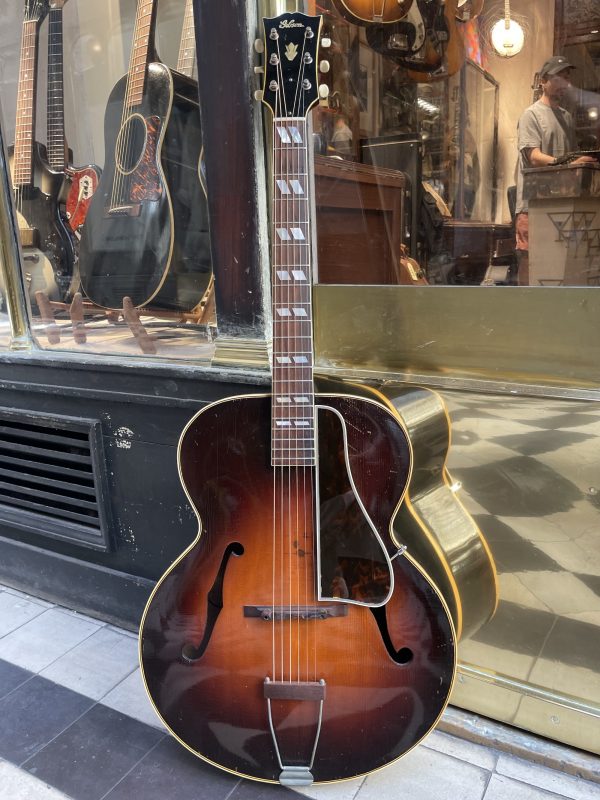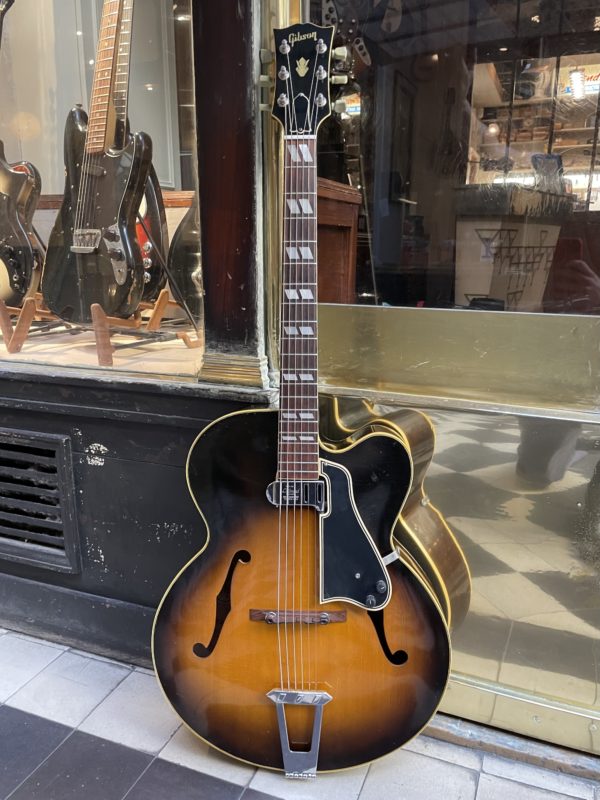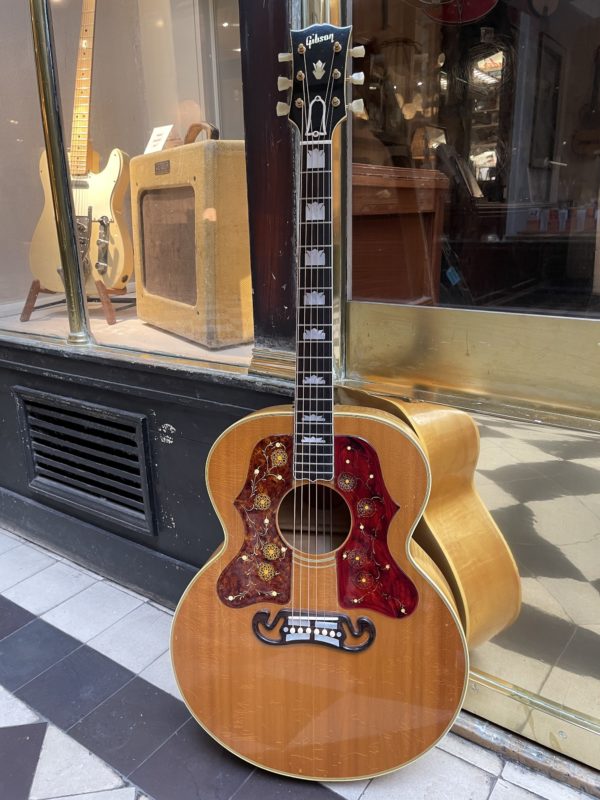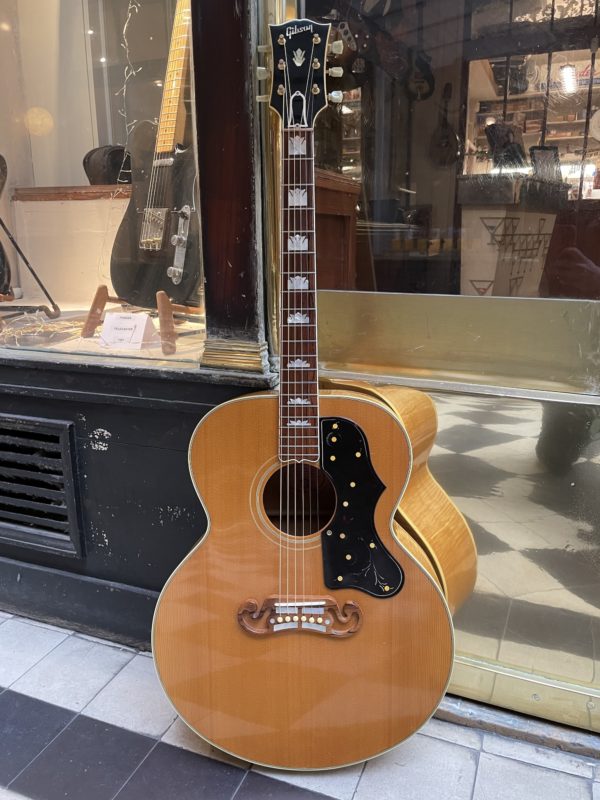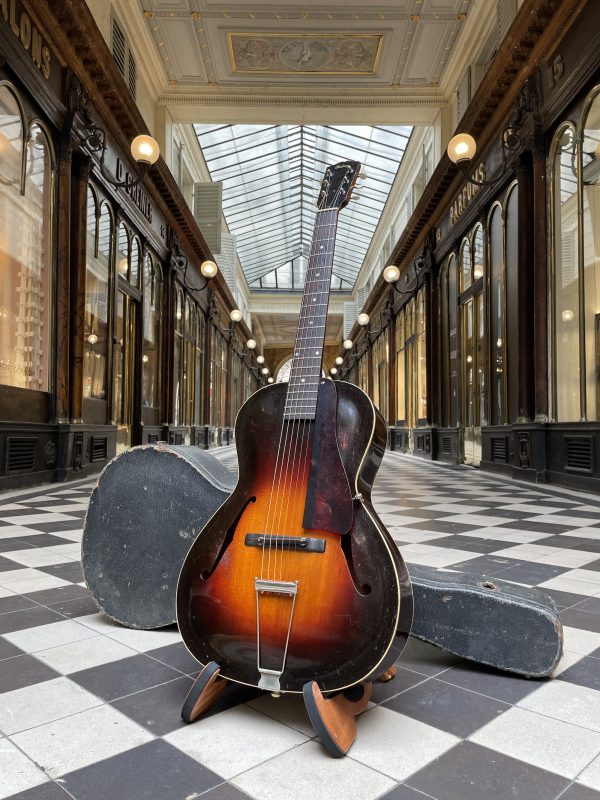Gibson Acoustic
Gibson Acoustic
ACOUSTIC GIBSON
Orville Gibson (1856-1918) was born in Chateaugay, New York, to English parents. From 1881, he lived in Kalamazoo, Michigan, where he worked for a shoe store, a non-musical job if ever there was one. However, the city is located in a highly industrialized region between Detroit and more importantly Chicago, where the large instrumental manufacturing companies are already well established and where manual labor is closely linked to mechanized production, which the future company Gibson will take advantage of.
Orville Gibson was an accomplished left-handed guitarist who played in a local quartet alongside Thaddeus McHugh (1859-1945) – future employee of the Gibson company, inventor of the adjustable metal truss rod and the adjustable bridge – he is also a young man animated by a passion for woodworking and lutherie, an self-taught worker who acts only according to his own parameters, a formalist and transcendent skeptic who sees in the mandolin and the guitar of his time instruments that could be improved in every way. His wish, as ambitious and eccentric as the character seems to have been, is to create a new concept around the manufacturing principles of the illustrious quartet maker Antonio Stradivari (1634-1737). His priority is first of all to revolutionize the very popular mandolin by modeling its construction after that of the violin, then to treat the guitar in a similar way, which he considers to be a simple member of the mandolin orchestra. In 1870, he gave birth to his first mandolins with limited tools closer to those of the handyman than those of the luthier and worked with wood borrowed from some old, very dry walnut furniture. His instruments are atypical and innovative: exclusively strung in steel strings, they have a carved top attached to sides and a back entirely carved from a single block of wood. As for the finishes, they border on a pre-art-deco aesthetic.
The great lutherie of the quartet applied to the guitar, a royal bridge thrown between the past and the present, then appears to some as a challenge, but the sorcerer’s apprentice’s instruments were met with more than a simple success of esteem with regard to their quality and originality. In 1894, Orville Gibson therefore decided to open a real workshop which would soon be formally established. His confidential work then remained experimental and strictly artisanal, but the reputation of the young luthier, which was talked about as far away as Europe, grew to the point of attracting a group of investors who persuaded him to set up a company to increase his ability to produce and disseminate his innovations. Although a minority partner and not associated in the group, Orville Gibson gave birth to the Gibson Manufacturing Co Ltd directed by John Adams from 1902 to 1944. For only a few months, he provided training for the thirteen employees, and the design of new models. Having sold his name and concepts to the company in exchange for a lifetime annuity, he would only intervene as a consultant until 1915, three years before his death due to psychiatric disorders. While Orville Gibson’s role was, on the whole, minor within the eponymous company founded in 1902, largely because of his health problems and a rather disinterested sense of business, his visionary spirit free from any constraint and its basic concepts truly founded the creative philosophy of Gibson and inspired his most eminent successors such as Lloyd Loar (1886-1943) or Ted McCarty (1909-2001). The young Gibson company will very quickly grow from a small workshop to a gigantic factory, part of which will remain in operation until 1984 but will relocate its production in 1974 to Tennessee for electric guitars and Montana for acoustic guitars. Only ES style guitars will continue to be made in Kalamazoo.
The first models of so-called archtop acoustic guitars manufactured by Orville Gibson are characterized by the following points: the top and the back are carved from a block of Norwegian spruce and present a significant arch and thickness; the bracing is reduced to a single transverse bar under the rosette; the sides are cut from a single block of walnut, also thick enough to carve out the top and bottom blocks; the neck is partially hollow to provide an additional resonance chamber; the flat, massive headstock most often features stylish tuners; the studded bridge is glued and screwed to the top; the decoration, sometimes reduced to its simplest expression, can be quite rich with ebony and abalone binding, a decorative butterfly made from mother-of-pearl and tortoiseshell inlayed in the top under the rosette and with a starry crescent moon on the head or even a fleur-de-lis. The finish is either black or natural or stained with a Cremona mahogany that foreshadows the sunburst to come. These guitars with a scale length of 650mm are disproportionately wide and thick in comparison with the instruments of the time: the thickness of the body reaches between 7 and 10 cm, the length of the body between 48 and 54 cm, the width between 29, 5 and 31 cm at the higher bout, 24.5 and 25.5 at the waist, and 40 and 44 cm at the lower bout. The harp-guitars, instruments which knew their heyday in the early 20th century, designed by Orville Gibson according to his principles and comprising of up to 12 additional bass strings, also exceeded by far the dimensions of the instruments of the same type of the other manufacturers.
To qualify the timbre and the power, or the playability of these instruments by the yardstick of the ear and the fingers of the 20th century would be anachronistic, nevertheless, these guitars constituted a real advance for the musicians who played them. This is even more the case of the Gibson Style O models produced from 1902, and especially Gibson L-5 appeared in 1923. The Gibson Style O is stamped The Gibson, brand of the company and not simply the name of Orville Gibson. This guitar is nevertheless marked with the O.G.’s inspiration: spruce top and maple back carved according to the same principles, sides also in maple, curved this time, but whose shoulders draw for one a large Florentine volute specific to the mandolins made by Orville Gibson, and for the floating bridge and tailpiece couple, the general dimensions are very nearly similar to the last models of the luthier in his own name; the black finish or natural wood stained red mahogany is taken up in a more refined way.
The Gibson Style O is in itself the starting point for the archtop models to come from which the Gibson L-5 originated. The latter is the fifth version and the accomplished form of the series of guitars prefixed L dedicated to orchestras. Its designer, Lloyd Loar, is celebrated as Gibson‘s most inventive employee, although he only directed the company’s designs for a few years. The specifications of the Gibson L-5 are quite similar to previous models but include a number of notable innovations: above all, the L-5 is the first guitar to sport soundholes in the shape of an “F”, thus finalizing the concept of Orville Gibson around the violin.
If the Gibson L-5 is the paragon of acoustic creativity of archtop guitars in general, it in particular has had many variations over time and is the object of a cult among some guitarists, if Gibson today offers a range of them including its most beautiful editions, it must be kept in mind that it is here the only truly innovative acoustic guitar sector for the company since the 1930s. If we are now talking about folk type guitars in the broad sense, it is clear that Gibson belatedly modeled its flat-top range on the innovations of the neighbors and very precisely on the catalogs of Martin. In a less subtle way than a few years later by developing the Gibson Les Paul under the commercial injunction of the competitor Fender, the creations of the old house Gibson are indeed reactions to the new market that the Martin company occupied better than anyone else from the mid-thirties.
It was from the archtop model accompanying mandolin orchestras, the Gibson L-1, that a first model finally equipped with a flat top saw the day in 1926. This guitar owes its success today to having rested in the voluble and tormented hands of the famous bluesman Robert Johnson (1911-1938). Just as Martin will choose a small model to lip service the steel string option in its catalog, Gibson chooses a very simple model in mahogany and sober in finish, far from the luxury of its top-of-the-range models, to make its entry, little noticed from the rest, in the world of flat-top guitars. The second draft of a flat-top will be much happier with a 1928 signature model – the first in Gibson guitar history! – with the Gibson Nick Lucas (1897-1982), a renowned and highly talented jazzman and singer who carried the Gibson colors high with this much more luxurious instrument since encrusted with a thousand mother-of-pearl wonders. The years of depression which will follow will soon have tempered the decorative ardor and it is the rustic models such as the Gibson L-0 and Gibson L-00 which will be able as advantageously as musically to make wait until 1933 for musicians who wanted more ornate models such as the Gibson LC-Century specially produced for the centennial of the city of Chicago, and its pearloid fingerboard itself encrusted with markers representing architectural vignettes. The year 1934 marked the entry into the catalog of a dreadnought format, essentially a copy of the Martin 14-fret model. This guitar is in a way the laboratory of the Gibson Advanced Jumbo which was born in 1936, an excellent alternative to the Martin D-28 which despite its intrinsic musical qualities will experience a bitter failure with its few unfortunate 271 copies manufactured… Somehow, Gibson was not expected in this field any more than it will be later on that of the electric guitar and that the venerable house will experience a bitter failure with the original Gibson Les Paul.
It was the Gibson J-35 model in mahogany, also produced from 1936, which was luckier. Gibson made few instruments during the Second World War, sacrificing its production strength on the altar of the war effort. It should be noted that at the end of the fighting the company was decorated twice by the government, something very rare, for this effort. Two gold stars were added to Gibson’s advertising flag on this occasion. The women who remained at the Gibson factory to sustain a semblance of guitar production became famous for making superb guitars that until 1946 are recognized by the words, like a promise, inscribed on a small banner-shaped decal stuck on the heads of the instruments: “Only a Gibson is Good Enough!“. These famous guitars, nicknamed today the Banner Headstock, are among the most popular and sought after on the vintage market. The immediate post-war period saw the Gibson J-35 model transform with a few details into Gibson J-45 (in sunburst) and Gibson J-50 (in natural finish). These models remain the touchstones of Gibson flat-tops to this day. Before coming to the truly creative model of the brand, it is necessary for good measure to mention two models which benefit from a particular affection among lovers of flat-top Gibson > : the Gibson Hummingbird and Gibson Dove models, which appeared in 1960 and 1962 respectively, and found the favor of many, including Keith Richards (1943-), Jimmy Page (1944-) and Marc Bolan (1947) -1977) or Tom Petty (1950-2017)! And even the King himself, the Immortal, but we will come back to this…
To any fan of the flat-top, the Gibson SJ-200 or Gibson J-200 model is strictly speaking the most honorable and original of Gibson’s creations, a one of the kind for the brand. Before a Bob Dylan (1941-), always generous with a contradiction or a provocation, appeared with this very luxurious model on the cover of his record Nashville Skyline, before Pete Townshend (1945-) only performed right-hand triplets on his natural model, only Cat Stevens (1948) restores its image, just as the very holy Reverend Gary Davis (1896-1972) already did, after the duo ideal sons-in-law of the Everly Brothers turned it into a tool of charm, the Gibson SJ-200 or Gibson J-200 was a guitar designed for a cowboy, for the great soap western star, the aptly named Ray Witley (1901-1979). Famous farmer-crooner – and inversely proportional – who in his films played both colt and guitar to save and pack the beautiful blonde on duty, he was approached by Guy Hart who managed Gibson from 1924 to 1948 with whom our man of taste defines the trappings of his new guitar matched with his sparkling boots and the dangling tassels of his horse saddle. Another treasure of American sub-culture. This new endorsement, after that of Nick Lucas and Roy Smeck (1900-1994) with his Hawaiian flat-top, is at the origin of the production of Gibson SJ-200 from 1938. The first pre-war models in Brazilian rosewood would not survive the war break, only to return in 1947 in beautiful maple.
But it is once again with the Only Revealed, the Unique Revered, the King Elvis Presley himself, that it is necessary to close off the topic of the flat-top Gibson SJ-200, which stuck to his skin as much as he to his maple wood. Amen.


